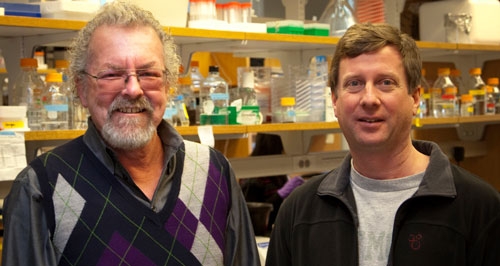In a new study, Dartmouth researchers describe the structure of a protein called ToxT that controls the virulent nature of Vibrio cholerae, the bacteria that causes cholera. Buried within ToxT, the researchers were surprised to find a fatty acid that appears to inhibit ToxT, which prevents the bacteria from causing cholera. Cholera, which causes acute diarrhea, can be life threatening, and, according to the World Health Organization, cholera remains a serious threat to global health.

Ronald Taylor and F. Jon Kull (photo by Joseph Mehling ’69)
Doctors have known that bile, found in the intestine, inhibits the expression of the virulence genes in V. cholerae, but until now, the mechanism behind this was not completely understood. This study provides a direct link between the environment of the gut and the regulation of virulence genes, and it also identifies the regulatory molecule.
“Finding a fatty acid in the structure was quite a surprise,” says F. Jon Kull, associate professor of chemistry at Dartmouth and senior author on the paper. Kull is also a 1988 graduate of Dartmouth. “The exciting thing about this finding is that we might be able to use a small, natural molecule to treat and/or prevent cholera. We will also use the structure of the fatty acid as a framework to try and design a small molecule inhibitor of ToxT.”
The study, “Structure of Vibrio cholerae ToxT reveals mechanism for fatty acid regulation of virulence genes,” appeared in the online edition of the Proceedings of the National Academy of Sciences during the week of February 1.
Kull’s co-authors on the paper are Michael Lowden and Maria Pellegrini with the Department of Chemistry at Dartmouth; Michael Chiorazzo, a summer undergraduate research fellow; and Karen Skorupski and Ronald Taylor with the Department of Microbiology and Immunology at Dartmouth Medical School.
The researchers used X-ray crystallography to determine the structure of ToxT. The process involves taking DNA from V. cholerae and using non-pathogenic E. coli bacteria to produce large amounts of the target protein, in this case, ToxT. Once protein has been purified, it is concentrated and crystallized. Then the crystal, which is an ordered array of protein molecules, is subjected to a powerful X-ray beam. The pattern of diffracted X-rays is collected on a detector and then analyzed using mathematical algorithms, eventually revealing the atomic structure of the protein.
Co-author Taylor also notes that “The results of the study are exciting from the points of view of both the mechanistic aspect of the complex regulation of V. cholerae virulence gene expression and the potential medical impact as we now move forward to apply this new knowledge to influence this mechanism to control infection in humans.”
This study was funded by the National Institutes of Health, Institute of Allergy and Infectious Diseases.
